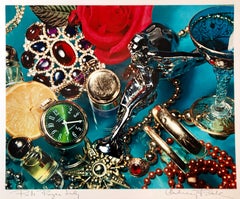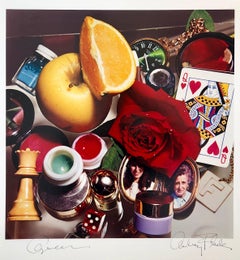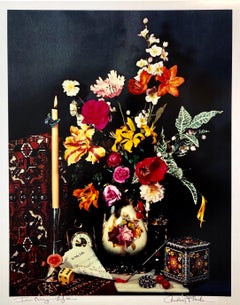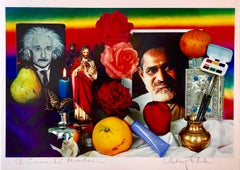Hampton Pocket Watch
1980s Photorealist Color Photography
Photographic Paper, C Print, Dye Transfer
1980s Photorealist Color Photography
Photographic Paper, C Print, Dye Transfer
1980s Photorealist Color Photography
Photographic Paper, C Print, Dye Transfer
1980s Photorealist Color Photography
Photographic Paper, C Print, Dye Transfer
1980s Photorealist Color Photography
Photographic Paper, C Print, Dye Transfer
Recent Sales
1980s Photorealist Color Photography
Photographic Paper, C Print, Dye Transfer
1980s Photorealist Color Photography
Photographic Paper, C Print, Dye Transfer
1980s Photorealist Color Photography
Photographic Paper, C Print, Dye Transfer
1980s Photorealist Color Photography
Photographic Paper, C Print, Dye Transfer
1980s Photorealist Color Photography
Photographic Paper, C Print, Dye Transfer
1980s Photorealist Color Photography
Photographic Paper, C Print, Dye Transfer
Audrey Flack for sale on 1stDibs
Audrey Flack is best known for her Photorealist paintings and was one of the first artists to use photographs as the basis for painting. The genre, taking its cues from Pop art, incorporates depictions of the real and the regular, from advertisements to cars to cosmetics.
Flack's photography, prints and paintings bring in everyday household items like tubes of lipstick, perfume bottles, Hispanic Madonnas, and fruit. These inanimate objects often disturb or crowd the pictorial space, which is often composed as table-top still lives. Flack often brings in actual accounts of history into her photorealist paintings, such as World War II (“Vanitas”) and Kennedy Motorcade. Women were frequently the subject of her photorealist paintings.
In her neoclassical public sculpture of gilded bronze angels, muses, and goddesses, Flack mines Greek mythology, presenting the female in an array of archetypal guises. Though some critics have condemned her focus on the classical white female, Flack is an avowed feminist, and many of her sculptures seek to reinvent their subjects and source material.
Flack's early work in the 1950s was Abstract Expressionist; one such painting paid tribute to Franz Kline. Most influential among her early supporters was the Bauhaus artist Josef Albers. It was he who persuaded Flack to take up a scholarship at Yale with the mission of shaking up the institution's stuffy academic reputation.
The ironic kitsch themes in Flack's early work influenced Jeff Koons. But gradually, Flack became a New Realist and then evolved into Photorealism during the 1960s. Her move to the Photorealist style was in part because she wanted her art to communicate to the viewer. Flack was the first Photorealist painter to be added to the collection of the Museum of Modern Art in 1966. Between 1976 and 1978 she painted her “Vanitas” series, including the piece Marilyn.
In the early 1980s, Flack's artistic medium shifted from painting to sculpture. She describes this shift as a desire for "something solid, real, tangible. Something to hold and to hold on to."
Flack discusses the fact that she is self-taught in sculpture. She incorporates religion and mythology into her sculpture rather than the historical or everyday subjects of her paintings. Her sculptures often demonstrate a connection to the female form, including a series of diverse, heroic women and goddess figures. These depictions of women differ from those of traditional femininity, but rather are athletic, older, and strong. As Flack describes them: "They are real yet idealized... the 'goddesses in everywoman.'"
Flack has claimed to have found the Photorealist movement too restricting and now gains much of her inspiration from Baroque art. She is currently represented by the Louis K. Meisel Gallery and Hollis Taggart Galleries. Her work is held in the collections of museums around the world, including the Metropolitan Museum of Art, the Museum of Modern Art, the Solomon R. Guggenheim Museum, the Whitney Museum of American Art, the Allen Memorial Art Museum, and the National Gallery of Australia in Canberra, Australia.
Flack was awarded the St. Gaudens Medal from Cooper Union and the honorary Albert Dome professorship from Bridgeport University. She is an honorary professor at George Washington University, is currently a visiting professor at the University of Pennsylvania, and has taught and lectured extensively both nationally and internationally.
Find original Audrey Flack art for sale on 1stDibs.
(Biography provided by Lions Gallery)
A Close Look at Photorealist Art
A direct challenge to Abstract Expressionism’s subjectivity and gestural vigor, Photorealism was informed by the Pop predilection for representational imagery, popular iconography and tools, like projectors and airbrushes, borrowed from the worlds of commercial art and design.
Whether gritty or gleaming, the subject matter favored by Photorealists is instantly, if vaguely, familiar. It’s the stuff of yellowing snapshots and fugitive memories. The bland and the garish alike flicker between crystal-clear reality and dreamy illusion, inviting the viewer to contemplate a single moment rather than igniting a story.
The virtues of the “photo” in Photorealist art — infused as they are with dazzling qualities that are easily blurred in reproduction — are as elusive as they are allusive. “Much Photorealist painting has the vacuity of proportion and intent of an idiot-savant, long on look and short on personal timbre,” John Arthur wrote (rather admiringly) in the catalogue essay for Realism/Photorealism, a 1980 exhibition at the Philbrook Museum of Art, in Tulsa, Oklahoma. At its best, Photorealism is a perpetually paused tug-of-war between the sacred and the profane, the general and the specific, the record and the object.
“Robert Bechtle invented Photorealism, in 1963,” says veteran art dealer Louis Meisel. “He took a picture of himself in the mirror with the car outside and then painted it. That was the first one.”
The meaning of the term, which began for Meisel as “a superficial way of defining and promoting a group of painters,” evolved with time, and the core group of Photorealists slowly expanded to include younger artists who traded Rolleiflexes for 60-megapixel cameras, using advanced digital technology to create paintings that transcend the detail of conventional photographs.
On 1stDibs, the collection of Photorealist art includes work by Richard Estes, Ralph Goings, Chuck Close, Audrey Flack, Charles Bell and others.
Finding the Right color-photography for You
Color photography evokes emotion that can bring a viewer into the scene. It can transport one to faraway places or back into the past.
The first color photograph, taken in 1861, was more of an exercise in science than art. Photographer Thomas Sutton and physicist James Clerk Maxwell used three separate exposures of a tartan ribbon — filtered through red, green and blue — and composited them into a single image, resulting in the first multicolor representation of an object.
Before this innovation, photographs were often tinted by hand. By the 1890s, color photography processes were introduced based on that 1860s experiment. In the early 20th century, autochromes brought color photography to a commercial audience.
Now color photography is widely available, with these historic photographs documenting moments and scenes that are still vivid generations later. Photographers in the 20th and 21st centuries have offered new perspectives in the evolving field of modern color photography with gripping portraiture, snow-capped landscapes, stunning architecture and lots more.
In the voluminous collection of photography on 1stDibs, find vibrant full-color images by Slim Aarons, Helen Levitt, Gordon Parks, Stefanie Schneider, Steve McCurry and other artists. Bring visual interest to any corner of your home with color photography — introduce a salon-style gallery hang or another arrangement that best fits your space.






